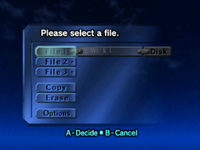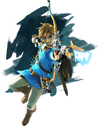Template:GameNav
Template:Game
The Legend of Zelda: Ocarina of Time Master Quest is a reworked version of the original Ocarina of Time for the Nintendo 64. Master Quest contains largely the same content as the original Ocarina of Time, but with redesigned, more difficult dungeons akin to a Second Quest.
Master Quest was available on a special bonus disc that also contained the original Ocarina of Time. This disc was given out in limited quantities with preorders of The Wind Waker. Additionally, it was sold packaged with The Wind Waker in some regions. It is also available in Ocarina of Time 3D after first completing the regular game.
History
In the late 1990s, Nintendo developed an add-on peripheral for the Nintendo 64 called the Nintendo 64DD. The Nintendo 64DD used magnetic disks, with a larger memory capacity than the cartridges used for the Nintendo 64, allowing for additional content and improved models and textures. While Nintendo hoped that the Nintendo 64DD would attract third-party developers, they also began developing several first-party titles, one of which was Ocarina of Time. Struggling to attract interest to the platform, Nintendo moved development of Ocarina of Time to the Nintendo 64, which was ultimately released on a cartridge.[1] At the time of this change, the game featured more content than the cartridges could hold and so parts of the game had to be removed.[1][2]
Ura Zelda

An Ocarina of Time save file that has been erroneously marked as a Ura Zelda save, as denoted by the "Disk" icon on the right side of the screen.
Shigeru Miyamoto announced that an expansion would follow Ocarina of Time, tentatively known as Ura Zelda. The expansion was purpoted to include new areas, items, sub-quests and enemies, as well as add rearranged dungeons from the original game in new locations in the overworld.[3][4] One new feature that was announced was an expanded mask trading sequence, with the ability to create custom masks using the Game Boy Camera and Mario Artist: Talent Studio.[3][5] Miyamoto also suggested the possibility of adding the content that was removed during development of the main game.[6] Another expansion pack was also announced, Zelda Gaiden, which was later released for the Nintendo 64 as the standalone Majora's Mask. Several concepts intended for Ura Zelda were eventually used in Majora's Mask, such as the expanded mask system.[7] The Nintendo 64DD became a commercial failure in Japan, and so most of Nintendo's planned titles for the 64DD, including Ura Zelda, were never released. Miyamoto insisted that the game would continue to be developed, and in August 2000 indicated that Ura Zelda had been completed for some time.[4] Despite this, Nintendo could not decide on how to release the game, and considered different methods such as a magazine tie-in.[8]
Remnants of Ura Zelda's 64DD origins remain in Ocarina of Time. Early Japanese releases of the game contain code to check for the presence of the expansion during start up. If the system is connected to a 64DD, the game will cease loading and display a message asking the player to insert a Ura Zelda disk.[6] There is also a glitch in other versions of the game in which a save file can be flagged as a Ura Zelda save. A "Disk" icon will appear next to the save file on the file select screen, and it will be permanently grayed out and inaccessible, as it can only be loaded with an expansion disk present. Attempting to copy or erase the file will crash the game.[9]
Master Quest
With the release of The Wind Waker, a special bonus was offered for pre-ordering the game. This bonus is a Nintendo GameCube disc containing Ocarina of Time, as well as a release of Ura Zelda, titled outside of Japan as The Legend of Zelda: Ocarina of Time Master Quest. Master Quest contains altered dungeons with a steeper difficulty level, as originally promised for Ura Zelda. Both games on the disc are emulations of Nintendo 64 ROMs, and not direct ports to the system. A modified version of Master Quest is included with Template:OOT3D for the Nintendo 3DS, but must be unlocked by completing the regular game first.
It is not clear whether Master Quest is identical to Ura Zelda, as several Ura Zelda features touted by Nintendo are not present in Master Quest. However in subsequent interviews, Miyamoto has stressed that Master Quest simply features remixed dungeons with no other changes, and insists that no content was removed when porting the original 64DD game.[8][10]
Changes from Ocarina of Time
The most notable feature of Master Quest is that every dungeon in the game has been modified to increase the difficulty of the game. Each one features a different layout, changing the progression through the levels. Enemies are spread differently throughout the dungeons, and tougher enemies are encountered much earlier on than in Ocarina of Time. In addition, some Gold Skulltula locations in dungeons have been moved, and certain items that are optional in the original version are now mandatory to complete the game.
Both games featured on the GameCube disc are displayed at quadruple the resolution of the Nintendo 64 version of Ocarina of Time, from 320 x 240 to 640 x 480, and the NTSC version of the game supports progressive scan.
Ocarina of Time 3D Version

The Master Quest for Ocarina of Time 3D has been completely mirrored
Master Quest for Ocarina of Time 3D is not available from the start. To unlock it, the main quest has to be completed first.[11] Upon doing so, the player will have an option to choose between the Main Quest or the Master Quest after starting up the game, allowing a second playthrough of the game with redesigned dungeons.
This version of the Master Quest has two significant changes. The entire game has been mirrored, similarly to Twilight Princess for the Wii, making Link right-handed as well as flipping the entire overworld map and the dungeons.[12] In addition to the game being mirrored, all of the enemies and bosses will cause twice as much damage to Link, which also applies to the Master Quest's own Boss Challenge version.[13]
The changes between normal gameplay and Master Quest in Ocarina of Time 3D appear similar to that of the PAL version of Luigi's Mansion's Hidden Mansion.
Additional Content
The disc for the GameCube also includes preview trailers for then-upcoming games published by Nintendo. The selection of trailers differ by region.
- The Wind Waker
- A Link to the Past & Four Swords
- Metroid Prime
- F-Zero GX
- 1080° Avalanche
- Wario World
- Hot Clips (montage of footage from various games)
Listings
Glitches
Hacks
Gallery
References
| Language | Name | Meaning | |
|---|---|---|---|
| Japanese | Template:Japanese | The Legend of Zelda: Ocarina of Time Another | |
| Korean | 시간의 오카리나 마스터 퀘스트 | ||



